Welcome to our free classical music site

Do you write about classical music? Are you a blogger? Want to team up with Classical Connect? Send us a message, let's talk!

Do you write about classical music? Are you a blogger? Want to team up with Classical Connect? Send us a message, let's talk!
July 17, 2017. Music of High Renaissance. With the dearth of prominent composers born this week, we’ll celebrated three great masters of the Renaissance whose birthdays remain unknown to music historians. Giovanni Pierluigi da Palestrina was born around 1525, Orlando di Lasso (or Orlande de Lassus, as his name is sometimes spelled) – in 1530 or 1532, and Tomás Luis de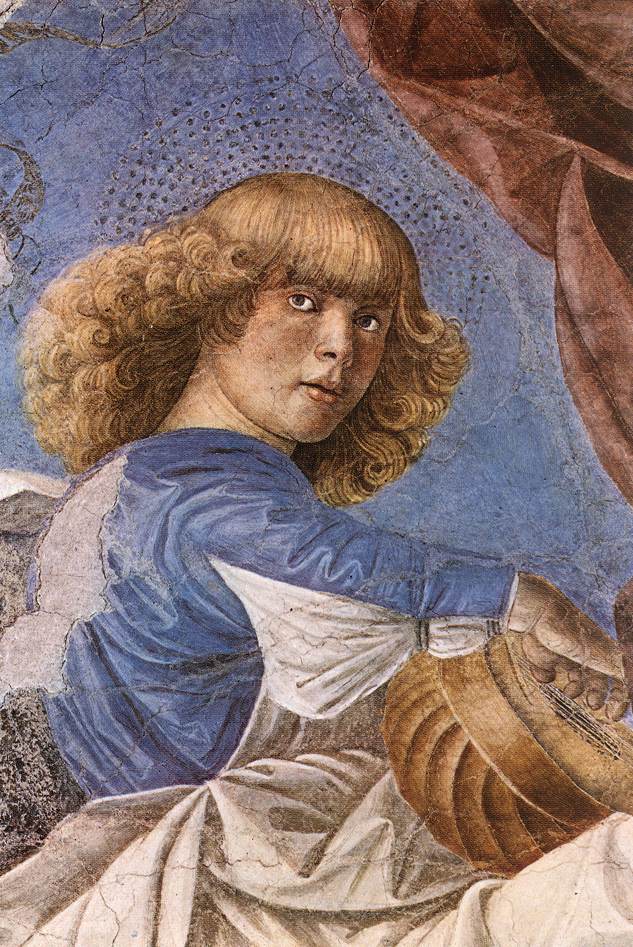 Victoria – in 1548. Even though Palestrina was the only Italian among the three (Lasso was Flemish, born in Mons, County of Hainaut, while Victoria was Spanish), Rome was the place were all three had lived and thrived artistically. Also, all three were influenced by the music of their Franco-Flemish predecessors, Josquin des Prez in particular. Palestrina, the great master of polyphony, was born in the town of the same name (“da Palestrina” means “from Palestrina”). In 1537, he was a chorister at the basilica of Santa Maria Maggiore in Rome but then had to return to Palestrina. His career didn’t take off till 1551, when Pope Julius III, the former Cardinal-Bishop of Palestrina, heard his music and appointed him maestro di cappella of the Cappella Giulia, one of the papal choirs at Saint Peter’s Basilica. In January of 1555 Palestrina was promoted to the Sistine Chapel, the pope’s official musical chapel. Unfortunately, just three months later Julius III died. Marcellus II became the pope (you can read about Palestrina’s famous Missa Papae Marcelli here) but he died three weeks later. The next pope, Paul IV, dismissed Palestrina from the Basilica as the composer was married (previous popes were happy to overlook this predicament). In October of the same year Palestrina was appointed maestro di cappella at the basilica of San Giovanni in Laterano, a position previously held by Lasso. In 1560, he moved to another great basilica, Santa Maria Maggiore. He returned to Saint Peter’s Capella Giulia in 1571 and remained there for the rest of his life. Palestrina died on February 2nd of 1594. He wrote more than 100 masses, 300 motets and 140 madrigals. Here’s one of his motets, Sicut Cervus, performed by the Cambridge Singers, John Rutter conducting.
Victoria – in 1548. Even though Palestrina was the only Italian among the three (Lasso was Flemish, born in Mons, County of Hainaut, while Victoria was Spanish), Rome was the place were all three had lived and thrived artistically. Also, all three were influenced by the music of their Franco-Flemish predecessors, Josquin des Prez in particular. Palestrina, the great master of polyphony, was born in the town of the same name (“da Palestrina” means “from Palestrina”). In 1537, he was a chorister at the basilica of Santa Maria Maggiore in Rome but then had to return to Palestrina. His career didn’t take off till 1551, when Pope Julius III, the former Cardinal-Bishop of Palestrina, heard his music and appointed him maestro di cappella of the Cappella Giulia, one of the papal choirs at Saint Peter’s Basilica. In January of 1555 Palestrina was promoted to the Sistine Chapel, the pope’s official musical chapel. Unfortunately, just three months later Julius III died. Marcellus II became the pope (you can read about Palestrina’s famous Missa Papae Marcelli here) but he died three weeks later. The next pope, Paul IV, dismissed Palestrina from the Basilica as the composer was married (previous popes were happy to overlook this predicament). In October of the same year Palestrina was appointed maestro di cappella at the basilica of San Giovanni in Laterano, a position previously held by Lasso. In 1560, he moved to another great basilica, Santa Maria Maggiore. He returned to Saint Peter’s Capella Giulia in 1571 and remained there for the rest of his life. Palestrina died on February 2nd of 1594. He wrote more than 100 masses, 300 motets and 140 madrigals. Here’s one of his motets, Sicut Cervus, performed by the Cambridge Singers, John Rutter conducting.
While Palestrina had lived in just two cities and traveled little, Orlando led a peripatetic life, at least the first half of it. He was twelve when he left Mons, accompanying Ferrante Gonzaga, an Italian condottiero, to Mantua and then Sicily. He then moved to Milan, where he probably met other musicians in the service of Ferrante. In 1550 he was in Naples, but then moved to Rome, where he found employment at the Roman residence of Cosimo I de' Medici, Grand Duke of Tuscany. In 1553, at the age of just 21, he became the maestro di cappella at San Giovanni in Laterano, a very prestigious position for such a young man. He stayed there for one year, and upon leaving embarked on a trip to France, England and Antwerp, where Tielman Susato published a collection of Orlando’s motets and madrigals, now knows as his Op. 1. In 1556 Orlando accepted an invitation to join the court of Duke of Bavaria Albrecht V in Munich. Orlando was hired as a singer (tenor) and composer, and it took him some years to acquire the position of maestro di cappella, but eventually he settled down in Munich, marrying a daughter of the Duchess’s maid of honor. As part of his duties, he wrote Masses for the morning and Magnificats for the evening services and many motets. He also supervised the musical education of the choirboys. As his fame as a composer grew, he was visited by many musicians. Andrea Gabrieli came in 1562 and stayed for two years, and Andrea’s nephew Giovanni joined him in the 1570s. Though he traveled quite a bit, he stayed employed with the dukes for the rest of his life. Here’s an excerpt from Orlando’s amazing Prophetiae Sibyllarum (Prophesies of the Sibyls), with the Hilliard Ensemble, Paul Hillier conducting.
We left almost no time for Tomás Luis de Victoria, the greatest Spanish composer of the 16th century who wrote the most profound music of the time. Victoria was born in a small town not far from Ávila, in which cathedral he was a choirboy. In 1565 he went to Rome. He almost certainly knew Palestrina and very likely was his pupil. Here’s his motet Vere languores. Ensemble The Sixteen is conducted by Harry Christophers.Permalink
July 10, 2017. Recent anniversaries: Gluck and more. We missed several significant anniversaries and will make up for at least some of them. The great reformer of the opera, Christoph Willibald Gluck was born in a small town of Erasbach in Bavaria on July 2nd of 1714. He was four when his family moved to Bohemia (Antonio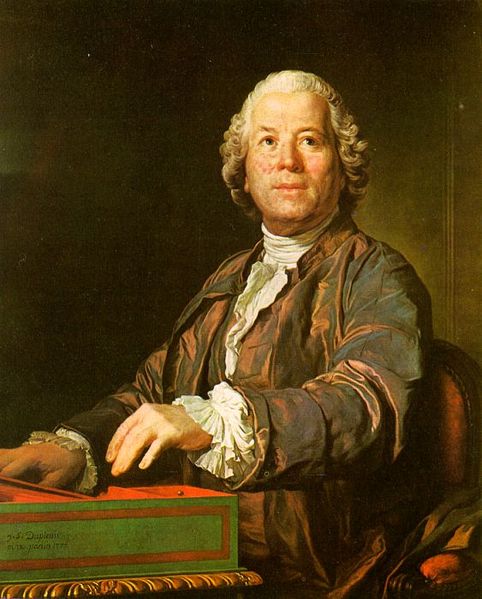 Salieri, his pupil, wrote in his memoir that Czech was Gluck’s native language and that he expressed himself in German with difficulty). Gluck studied mathematics at the university of Prague but probably never graduated. In 1737 he went to Milan to study music with Giuseppe Sammartini. Gluck’s first opera was Artaserse, on the libretto of the famous Metastasio, composed for the Carnival of 1742 and performed in the Teatro Regio Ducal (the theater, one of the largest in Milan, burned down in 1776 and as his replacement Nuovo Regio Ducal Teatro alla Scala was built; we now know it as La Scala). In 1745 Gluck traveled to London. There he composed an opera, but more importantly, became familiar with the operas of George Frideric Handel. Handel was not terribly impressed with Gluck’s compositions: the music historian Charles Burney wrote in his “Life of Handel” that the great master said of Gluck “he knows no more of contrapunto, as mein cook, Waltz” (an interesting mixture of three languages that is). Gluck didn’t stay in London for too long; in 1747 he was back in Vienna, writing an opera to celebrate the Empress Maria Theresa's birthday. The opera was La Semiramide riconosciuta, again on Metastasio's libretto, and the assignment was very prestigious: Gluck got it ahead of the much more established Johann Adolph Hasse. The opera was a popular success but Metastasio called it “archvandalian music, which is insupportable’” and Gluck left Vienna shortly after. For the next few years Gluck earned money as an “itinerant maestro di cappella,” moving around Europe, first with the troupe of the impresario Pietro Mingotti and later with the troupe of Giovanni Battista Locatelli. He directed different orchestras, composed, and staged productions of his own operas. One of them was La clemenza di Tito, written on Metastasio’s old libretto. The opera, composed to celebrate the name day of King Charles VII of Naples, was performed in Teatro di San Carlo, Naples’s most important theater, and featured the famous soprano castrato Cafarelli. One aria, the exceptionally difficult Se mai senti spirarti sul volto, became especially popular. Castratos disappeared from opera stages by the end of the 19th century; fortunately, we have the incomparable Cecilia Bartoli, who brought to life so many arias from the castrato repertoire. Here she is in Se mai senti recorded live in 2001; the ensemble Akademie für Alte Musik Berlin is conducted by Bernhard Forck. As for La Clemenza, it proved to be a very popular libretto. Gluck’s 1752 rendition wasn’t the first one: Antonio Caldara wrote an opera in 1734, and before Gluck there were 17 more operas written on the same text, Hasse using it not once but three times, creating different version in 1735, 1738 and then in 1759. Of the famous composers, Baldassare Galuppi and Josef Myslivecek used the libretto. Altogether, 45 operas were written to Metastasio’s piece. But the most famous one was, without a doubt, the one written by Mozart in 1791, his last one.
Salieri, his pupil, wrote in his memoir that Czech was Gluck’s native language and that he expressed himself in German with difficulty). Gluck studied mathematics at the university of Prague but probably never graduated. In 1737 he went to Milan to study music with Giuseppe Sammartini. Gluck’s first opera was Artaserse, on the libretto of the famous Metastasio, composed for the Carnival of 1742 and performed in the Teatro Regio Ducal (the theater, one of the largest in Milan, burned down in 1776 and as his replacement Nuovo Regio Ducal Teatro alla Scala was built; we now know it as La Scala). In 1745 Gluck traveled to London. There he composed an opera, but more importantly, became familiar with the operas of George Frideric Handel. Handel was not terribly impressed with Gluck’s compositions: the music historian Charles Burney wrote in his “Life of Handel” that the great master said of Gluck “he knows no more of contrapunto, as mein cook, Waltz” (an interesting mixture of three languages that is). Gluck didn’t stay in London for too long; in 1747 he was back in Vienna, writing an opera to celebrate the Empress Maria Theresa's birthday. The opera was La Semiramide riconosciuta, again on Metastasio's libretto, and the assignment was very prestigious: Gluck got it ahead of the much more established Johann Adolph Hasse. The opera was a popular success but Metastasio called it “archvandalian music, which is insupportable’” and Gluck left Vienna shortly after. For the next few years Gluck earned money as an “itinerant maestro di cappella,” moving around Europe, first with the troupe of the impresario Pietro Mingotti and later with the troupe of Giovanni Battista Locatelli. He directed different orchestras, composed, and staged productions of his own operas. One of them was La clemenza di Tito, written on Metastasio’s old libretto. The opera, composed to celebrate the name day of King Charles VII of Naples, was performed in Teatro di San Carlo, Naples’s most important theater, and featured the famous soprano castrato Cafarelli. One aria, the exceptionally difficult Se mai senti spirarti sul volto, became especially popular. Castratos disappeared from opera stages by the end of the 19th century; fortunately, we have the incomparable Cecilia Bartoli, who brought to life so many arias from the castrato repertoire. Here she is in Se mai senti recorded live in 2001; the ensemble Akademie für Alte Musik Berlin is conducted by Bernhard Forck. As for La Clemenza, it proved to be a very popular libretto. Gluck’s 1752 rendition wasn’t the first one: Antonio Caldara wrote an opera in 1734, and before Gluck there were 17 more operas written on the same text, Hasse using it not once but three times, creating different version in 1735, 1738 and then in 1759. Of the famous composers, Baldassare Galuppi and Josef Myslivecek used the libretto. Altogether, 45 operas were written to Metastasio’s piece. But the most famous one was, without a doubt, the one written by Mozart in 1791, his last one.
By 1751 Gluck settled in Vienna. The most productive, but also the most disappointing period of his life was still ahead of him. We’ll write about it another time.
Two more names we’d like to mention: another Czech-speaker, the composer Leoš Janáček was born on July 3rd of 1854. And the Italian composer Ottorino Respighi was born on this day, July 9th of 1879.Permalink
July 3, 2017. Mahler, Symphony no. 5. Gustav Mahler was born on July 7th of 1860, and to celebrate his birthday we will again turn to one of his symphonies, this time the Fifth. The time of its composition, the years of 1901 and 1902, is closely linked to Mahler’s marriage to Alma Schindler. In 1897 Mahler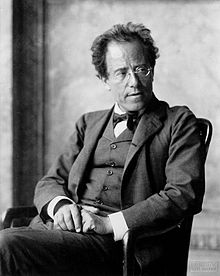 was appointed the music director of the Vienna Hofoper, one of the most important opera theaters in Europe, whose orchestra, the Vienna Philharmonic, was (and still is) one of the best. Mahler’s early years as the director were rather turbulent. As he was mounting new opera productions (the first two were Wagner’s Lohengrin and Mozart’s Zauberflöte), Mahler required utter discipline and precision. Very demanding, he was not too sensitive toward the singers and orchestra players, whose feelings he often hurt. The atmosphere within the opera house was difficult but results were of a very high quality. Problems of a different sort accompanied Mahler as the conductor of subscription concerts with the Vienna Philharmonic. To many conservative music critic, he appeared not sufficiently felicitous to the classical scores. And indeed, Mahler often altered the orchestration and was known to amplify musical dynamics beyond the generally accepted practices of the day. Things were exacerbated by the partisan, and often very hostile, critics. A large section of the society was deeply anti-Semitic (the Mayor of Vienna, Karl Lueger, was the leader of the anti-Semitic Austrian Christian Social Party), and even though Mahler converted to Christianity to take a position with the Hofoper, they never forgot his Jewish roots.
was appointed the music director of the Vienna Hofoper, one of the most important opera theaters in Europe, whose orchestra, the Vienna Philharmonic, was (and still is) one of the best. Mahler’s early years as the director were rather turbulent. As he was mounting new opera productions (the first two were Wagner’s Lohengrin and Mozart’s Zauberflöte), Mahler required utter discipline and precision. Very demanding, he was not too sensitive toward the singers and orchestra players, whose feelings he often hurt. The atmosphere within the opera house was difficult but results were of a very high quality. Problems of a different sort accompanied Mahler as the conductor of subscription concerts with the Vienna Philharmonic. To many conservative music critic, he appeared not sufficiently felicitous to the classical scores. And indeed, Mahler often altered the orchestration and was known to amplify musical dynamics beyond the generally accepted practices of the day. Things were exacerbated by the partisan, and often very hostile, critics. A large section of the society was deeply anti-Semitic (the Mayor of Vienna, Karl Lueger, was the leader of the anti-Semitic Austrian Christian Social Party), and even though Mahler converted to Christianity to take a position with the Hofoper, they never forgot his Jewish roots.
Nonetheless, by 1901 things were settling down. Mahler resigned as the conductor of the Philharmonic series (his re-orchestration of Beethoven’s Ninth symphony cause a real scandal), concentrating on opera. His own compositions were getting wider acceptance. He was financially secure, and could even afford a villa, in Maiernigg on the Wörthersee. The summer of 1901 was the first one of many that he spent there, composing. In November of 1901, at a dinner party given by Sofie Clemenceau (sister-in-law of George Clemenceau, the future Prime-minister of France) he met Alma Schindler. Alma, the daughter of an established landscape painter Emil Schindler, was then 22 (and 19 years younger than Mahler). She was known as a fine-looking society girl. At the time, Alma was having an affair with the composer Alexander von Zemlinsky, her music teacher. That didn’t prevent a brief but intense romance between her and Gustav, and on March 9th of 1902 they were married. One of the conditions of the marriage, imposed by Gustav, was that Alma would drop her own composition efforts (Mahler changed his attitude some years later, helping Alma to edit and publish several of her compositions). Both Mahler’s friends and his enemies were surprised: the friends, because they considered Alma to be too young for Gustav and too flirtatious, his enemies – because they considered her too pretty and too much a part of the society to marry a Jew. But by the time of the marriage Alma was already pregnant with their first daughter and happy to assume her conjugal responsibilities.
By then Mahler had already started working on his Fifth symphony. He and Alma spent the summer months of 1902 at their Maiernigg villa. Mahler built a separate small studio, where he spent the morning hours composing. By the end of the summer of 1902 the Fifth symphony was finished, although it would wait for the premier for another two years. Here it is, in the 1996 performance by the Vienna Philharmonic, Pierre Boulez conducting.Permalink
June 26, 2017. Beethoven, Symphony No. 7. Below is the article by Joseph DuBose on Beethoven’s Symphony no.7. As always with Beethoven’s symphonies, our problem was in selecting a recording to illustrate it: there are myriads in existence, many of superb quality. We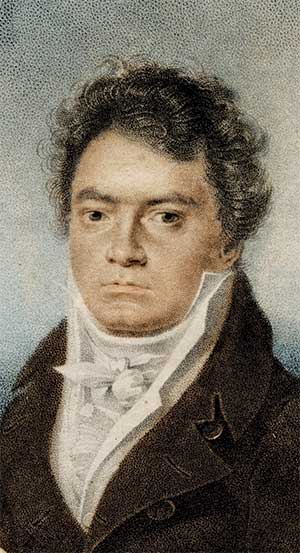 chose a remastered live recording made by Carlos Kleiber with the Vienna Philharmonic orchestra in 1976. You can listen to it here. ♫
chose a remastered live recording made by Carlos Kleiber with the Vienna Philharmonic orchestra in 1976. You can listen to it here. ♫
Symphony No. 7 in A major
Beethoven completed the Symphony No. 7 in 1812. Four years separated it from the “Pastoral”—the longest span between any of the symphonies thus far. Yet, that interval does not mark a period of lesser creativity in Beethoven’s career. Many important works appeared during that time, including two string quartets (opp. 74 and 95), the music for “Egmont,” “King Stephen,” and the “Ruins of Athens,” the Choral Fantasia, and the F-sharp minor and “Les Adieux” piano sonatas.
Beethoven’s style continued to advance during this period. With each decisive step he brought music closer to embodying the deepest expressions of the human soul. Thus far, his music had embodied the grand, the lofty, the profound, and, quite remarkably, was largely uninfluenced by the day-to-day events of the composer's life. What Beethoven had not yet explored, at least in his symphonies, was humor. Beethoven had always indulged in coarse jokes, puns, and nicknames, but in his later years, his humor became even more pronounced. He even had a special word for his unique, off-putting behavior: aufgeknöptf, or “unbuttoned.” In one such instance of this behavior, Beethoven, when visiting his friend Breuning, would, if having just come in from the rain, take off his hat and dash water off it in all possible directions, without the slightest regard for what furniture or people may have been nearby. Another example involved his brother. When Johann left a card for Beethoven that read, “Johann van Beethoven, Landed proprietor,” Beethoven quickly responded with his own: “Ludwig van Beethoven, Brain proprietor.” Though brief glimpses of this rough humor can be found as early as the Second Symphony, Beethoven had not yet allowed it an outlet in his music until the composition of the A major Symphony.
Besides allowing his “unbuttoned” humor a musical outlet, Beethoven composed the Seventh Symphony during a particularly happy time for the composer. As was his habit, the composer left Vienna during the summer months for the countryside, where he sketched out his compositions that would later be put into their final form once he returned to Vienna for the winter. In the summer of 1811, he ventured farther from the Austrian capital than usual, to Teplitz, roughly fifty miles from Prague. There, he enjoyed a vibrant confluence of intellectuals and musicians, among them the Sebald family; the actor Ludwig Lowe; Johann Fichte, a founding figure of German idealism; and the poet Christoph Tiedge. Afternoons and evenings were spent with great fellowship, and Beethoven, against his usual manner, even obliged to extemporize at the piano.
Once completed, the Seventh Symphony was premiered on December 8, 1813 at a concert in Vienna given to benefit the soldiers wounded at the battle of Hanau, where Austrian and Bavarian troops attempted to cut off Napoleon’s retreat from Leipzig. The program also included Beethoven’s “Battle Symphony” in honor of the British victory over Napeleon at Vittoria. Among the orchestra were some of the most prominent musicians of the day—Schuppanzigh, Romberg, Spohr, Dagonetti, Meyerbeer, Hummel, and Salieri. Beethoven himself conducted the concert, though probably more to the performance’s detriment than advantage due to the advanced stage of his deafness by this time. Yet, the Symphony No. 7 was received with great praise; the Allegretto even was encored. A repeat performance on the 12th of the same month met with equal success. The work, however, did not fare as well in North Germany. When it was premiered in Leipzig, Friedrich Wieck, father of Clara Wieck, criticized the symphony, remarking that it could have only been composed in a “drunken state.” Regardless, the Seventh now is staple of the symphonic repertoire, and, along with the Eroica and the Fifth, one of the most oft-performed of Beethoven’s symphonies. Beethoven himself was particularly fond of the work, and twice referred to it as one of his best works. (To continue reading, please click here)Permalink
June 19, 2017. A Stamitz and a Bach. Johann Stamitz was born on this day in 1717 in a small town of Německý Brod (German Ford in the Czech) in Moravia, then part of the Austrian Empire. He studied in the Jesuit Gymnasium in Jihlava known across Europe for its high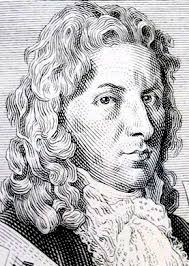 quality of musical education. He then studied at Prague University and then, it’s assumed, embarked on a career of a violin virtuoso. Sometime around 1741 Stamitz was hired by the Mannheim court of the Elector of Palatinate. At the time, the court had an excellent orchestra. In June of 1742 he played at a concert and, according to the advertisement, was to perform on the violin, viola d’amore, cello and double bass. His rise was very quick: a year later he became the first violinist of the court orchestra, in 1745 – the Konzertmeister and in 1750 – director of instrumental music. As such he was responsible for both composing and performing music for the court. Under the leadership of Stamitz the orchestra improved even further, both technically and musically, becoming the most renowned orchestra in Europe. In 1754, Stamiz went to Paris and stayed there for a year. He performed, to great acclaim, in private residences of the nobility and also at the Concert Spirituel at the Tuileries Palace, the first ever public concert series. Stamiz returned to Mannheim in the fall of 1755. Two years later, on March 27th of 1757, he died at the age of 39. Johann Stamitz, had two composer sons who became as well known as their father, and is mostly famous for his symphonies (he wrote 58 of them) and his orchestral trios. Here is his Pastorale Symphony. Virtuosi di Praga are conducted by Oldřich Vlček.
quality of musical education. He then studied at Prague University and then, it’s assumed, embarked on a career of a violin virtuoso. Sometime around 1741 Stamitz was hired by the Mannheim court of the Elector of Palatinate. At the time, the court had an excellent orchestra. In June of 1742 he played at a concert and, according to the advertisement, was to perform on the violin, viola d’amore, cello and double bass. His rise was very quick: a year later he became the first violinist of the court orchestra, in 1745 – the Konzertmeister and in 1750 – director of instrumental music. As such he was responsible for both composing and performing music for the court. Under the leadership of Stamitz the orchestra improved even further, both technically and musically, becoming the most renowned orchestra in Europe. In 1754, Stamiz went to Paris and stayed there for a year. He performed, to great acclaim, in private residences of the nobility and also at the Concert Spirituel at the Tuileries Palace, the first ever public concert series. Stamiz returned to Mannheim in the fall of 1755. Two years later, on March 27th of 1757, he died at the age of 39. Johann Stamitz, had two composer sons who became as well known as their father, and is mostly famous for his symphonies (he wrote 58 of them) and his orchestral trios. Here is his Pastorale Symphony. Virtuosi di Praga are conducted by Oldřich Vlček.
Johann Stamitz was three years younger than Carl Philipp Emanuel Bach and 15 years older than another son of J.S. Bach, Johann Christoph Friedrich Bach. Johann Christoph was born this week, on June 21st of 1732 in Leipzig, where his famous father was the Thomaskantor. Johann Sebastian was his son’s first music teacher, and, as many of Johann Sebastian’s sons, Johann Christoph attended the Thomasschule (St. Thomas School). Not as famous as his brothers Wilhelm Friedemann, Carl Philipp Emanuel, or Johann Christian, he was a fine composer and a virtuoso keyboard player. Johann Christoph is sometimes called the "Bückeburg Bach" as he spent many years in Bückeburg, the capital of the County of Schaumburg-Lippe. Here is Johann Christoph’s virtuosic Piano Concerto E Major. It’s performed by the wonderful Cyprien Katsaris. Orchestre de Chambre du Festival d`Echternach is conducted by Yoon Lee.Permalink
June 12, 2017. Stravinsky, Pleyel. Igor Stravinsky, one of the most influential composers of the 20th century, was born on June 17th of 1882 in Oranienbaum (now Lomonosov) outside of Saint Petersburg. For years, as we celebrated Stravinsky, we were traversing his life in its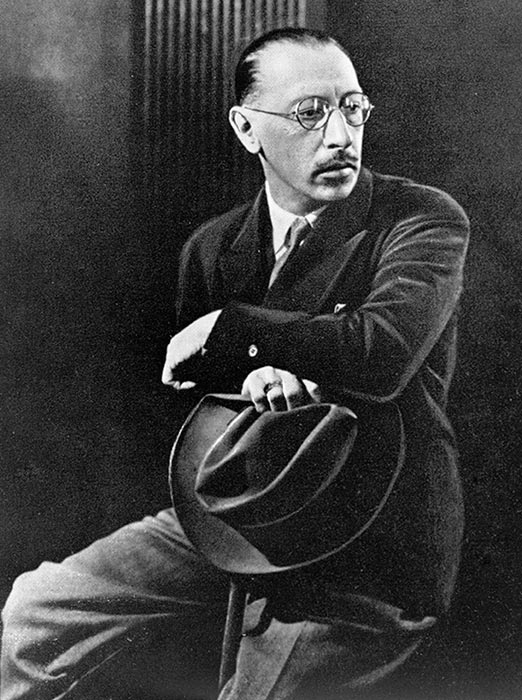 amazing transmutations. We’ve mentioned it before, but one can think of only one other artist who could change his creative styles so drastically and succeeded so enormously in every one of them – and that’s Picasso. Last year we wrote about one of Stravinsky’s most successful neoclassical pieces, his ballet Apollo. Apollo was composed early in 1928. Stravinsky was living in France and leading, at least on a personal level, a double life: while still married to Catherine (Katya) Nosenko, mother of his four children, he had since 1921 been carrying on an affair with Vera de Bosset, then the wife of the painter Sergei Sudeikin (Vera would leave Sudeikin a year later). Stravinsky bought a house in Anglet just outside of Biarritz and moved his family there. When not visiting Anglet, he lived in Paris with Vera. Katya knew about the affair but didn’t do anything about it. Stravinsky stayed married to Katya for the remainder of her life; the last years were very unhappy. Some years earlier Katya had contracted tuberculosis, which had developed slowly, but in 1938 she infected both Igor and their daughter Lyudmila. Lyudmila died in 1930 at the age of 30, Catherine – three months later, in March of 1939. Igor spent several months in a hospital but recovered.
amazing transmutations. We’ve mentioned it before, but one can think of only one other artist who could change his creative styles so drastically and succeeded so enormously in every one of them – and that’s Picasso. Last year we wrote about one of Stravinsky’s most successful neoclassical pieces, his ballet Apollo. Apollo was composed early in 1928. Stravinsky was living in France and leading, at least on a personal level, a double life: while still married to Catherine (Katya) Nosenko, mother of his four children, he had since 1921 been carrying on an affair with Vera de Bosset, then the wife of the painter Sergei Sudeikin (Vera would leave Sudeikin a year later). Stravinsky bought a house in Anglet just outside of Biarritz and moved his family there. When not visiting Anglet, he lived in Paris with Vera. Katya knew about the affair but didn’t do anything about it. Stravinsky stayed married to Katya for the remainder of her life; the last years were very unhappy. Some years earlier Katya had contracted tuberculosis, which had developed slowly, but in 1938 she infected both Igor and their daughter Lyudmila. Lyudmila died in 1930 at the age of 30, Catherine – three months later, in March of 1939. Igor spent several months in a hospital but recovered.
But that was still to come. In the meantime, in 1928, following the success of Apollo, Ida Rubinstein, a famous danseuse, commissioned Stravinsky for another ballet for her company. Rubinstein wanted a romantic tale, and Alexander Benois, a wonderful Russian painter who had collaborated with Stravinsky (and Diagilev) on a number of projects, came up with the idea to base the ballet on the music of Tchaikovsky. Stravinsky liked it; what came out of it was Le baiser de la fée (The Fairy's Kiss), a wonderfully inventive one-act ballet. Bronislava Nijinska was the choreographer; the ballet premiered in November of 1938, marking the 35th anniversary of Tchaikovsky’s death. It’s interesting to compare two masterpieces, Apollo and The Fairy's Kiss, written just months apart – the apollonian stillness of the former and the inventive brilliancy of the latter. In 1934 Stravinsky wrote a “Divertimento” – a suite based on the music of the ballet. You can listen to it here. The Bulgarian National Radio Symphony is conducted by Mark Kadin.
While in Paris, Stravinsky found an interesting source of income: writing arrangements for the piano manufacturer Pleyel. The company had recently designed a piano player they called Pleyela and Stravinsky used its ability to play notes beyond the capacity of a human pianist. By the late 1920, Playel was one of the major piano manufacturers in Europe, on par with Bechstein, Bösendorfer and the Hamburg Steinway. The company was started by Ignaz Pleyel, a composer and piano maker, whose birthday we also mark this week. Pleyel was born on June 18th of 1757 in Ruppersthal, Austria. He moved to Strasbourg, Alsace, and eventually to Paris. A prolific composer of many symphonies, quartets, etc., he didn’t leave a lasting mark, although he was well-received in England, which he toured the same time as his friend Haydn. The field he really excelled in was business. First, he established a successful music printing business, and then, in 1807, Pleyel et Cie, a piano manufacturer. They were the first to introduce a metal frame and make an upright piano (or “pianino,” as they called it). Chopin played Pleyels, and so did many other French pianists and composers. Working with Wanda Landowska, they introduced the modern harpsichord. And we shouldn’t forget their contribution to the performing scene: the company commissioned the original small Salle Pleyel and its replacement, the modern concert hall which serves as the home base to the Orchestre de Paris Orchestre Philharmonique de Radio France. Igor Stravinsky was one of the conductors of the inauguration concert.Permalink